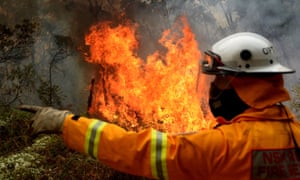Higher temperatures, dryer fuel and strong winds in autumn and spring are making it unsafe to burn
In
April 2005, a fire burnt much of Victoria’s beloved national park at
Wilsons Promontory leading to the evacuation of holidaymakers from Tidal
River. The fire was the result of a fuel reduction burn, which escaped
10 days after it was lit when the weather became hot and windy. I
remember it well as I was Victoria’s environment minister at the time,
responsible for the park and the burn.
The then premier Steve Bracks was one of the campers evacuated.
In 2015 a fuel reduction burn at Lancefield in Victoria escaped, causing a fire that destroyed six homes and caused a great deal of anguish for the local community. There have been many such instances of fuel reduction burns escaping and causing damage in different parts of Australia. The risk of putting fire in the landscape for fuel reduction is real.
For years, elements of the media have promoted the idea that
“greenies” and environmentalists have prevented fuel reduction burning.
This particularly suits those with an agenda to deny climate change as
it simultaneously advances the culture war against environmentalists and
draws attention away from the need to take action on climate change. As
environment minister, I don’t recall ever being influenced or lobbied
by environmentalists or “greens” to stop fuel reduction burns.The then premier Steve Bracks was one of the campers evacuated.
In 2015 a fuel reduction burn at Lancefield in Victoria escaped, causing a fire that destroyed six homes and caused a great deal of anguish for the local community. There have been many such instances of fuel reduction burns escaping and causing damage in different parts of Australia. The risk of putting fire in the landscape for fuel reduction is real.
What does stand in the way of planned burns is climate change: higher temperatures, dryer fuel and strong winds in autumn and spring making it unsafe to burn. A shorter timeframe for safe burning – not “debate by environmentalists” – is the overwhelming factor.
Much attention has been given to the recommendation of the Victorian Bushfires Royal Commission to implement a program of planned burning based on an annual target of 5% of public land – 390,000 hectares for Victoria. The former Victorian premier Jeff Kennett and others have criticised the Victorian government for not achieving this target.
However, these criticisms not only ignore the climate-related difficulties with planned burning, they also fail to take account of the expert advice received in the years since the royal commission reported.
The weather-related difficulties in achieving a hectare-based target were born out in 2014, the last year of the Napthine Coalition government, when only 82,022 hectares were burnt despite the government’s commitment to the 5% target. Kennett’s government itself could manage only 40,000 hectares of planned burning in 1997-98 and I had the same experience myself when I was minister in the very dry and hot 2006 year.
The royal commission itself acknowledged that planned burning is risky and only available in limited timeframes. The royal commission also recommended that the Victorian government appoint an independent person to monitor the implementation of its recommendations. The former police chief commissioner Neil Comrie was appointed to the role and in his reports in 2012 and 2013 recommended that the planned burning target of 5% be replaced. Comrie concluded that the 5% was not “achievable, affordable or sustainable” and recommended that it be replaced by a risk-based approach with a primary focus on human life and safety.
Following Comrie’s reports, the Inspector General of Emergency Management recommended a change from a hectare-based target for planned burns to a risk reduction target. A group of fire experts from around the country reviewed this recommendation and backed the changed approach because it focuses on the areas of highest risk rather than on burning broad acres for the sake of meeting a target. The risk-based approach also creates incentives to pursue alternative forms of risk reduction such as mowing and slashing when planned burning is not possible.
In 2016, the Victorian government agreed to adopt this new approach, which means that fuel reduction is now done in a way to maximise the reduction in risk to people and their homes rather than simply burning as many hectares as possible. Fuel reduction burns are now carefully planned using computer-based fire models that indicate where the burning is likely to be most effective. The target is to reduce the risk that homes will be lost by 30%, which experts advised is the right level across the state.
Planned burns cannot guarantee that homes will be saved. They are most effective when the fire is at ground level, but they are of limited effect on the most dangerous fire weather days when a fire can race across tree crowns or across already burnt areas.
Fuel reduction burns should be part of the toolkit that our firefighting agencies have to tackle the ever-growing risk of bushfire. They should not be used as a weapon in the culture wars in order to divert attention from the need to act on climate change.
- John Thwaites is the chair of Monash Sustainable Development Institute and ClimateWorks Australia and a former deputy premier and environment minister in Victoria

No comments:
Post a Comment